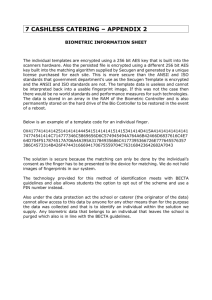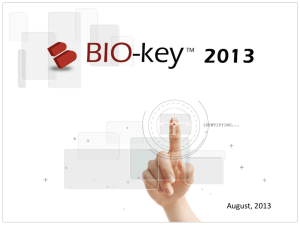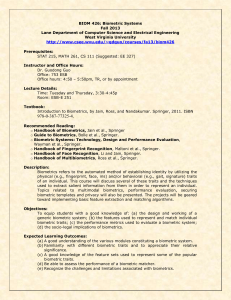Biometric methods of animal identification
advertisement
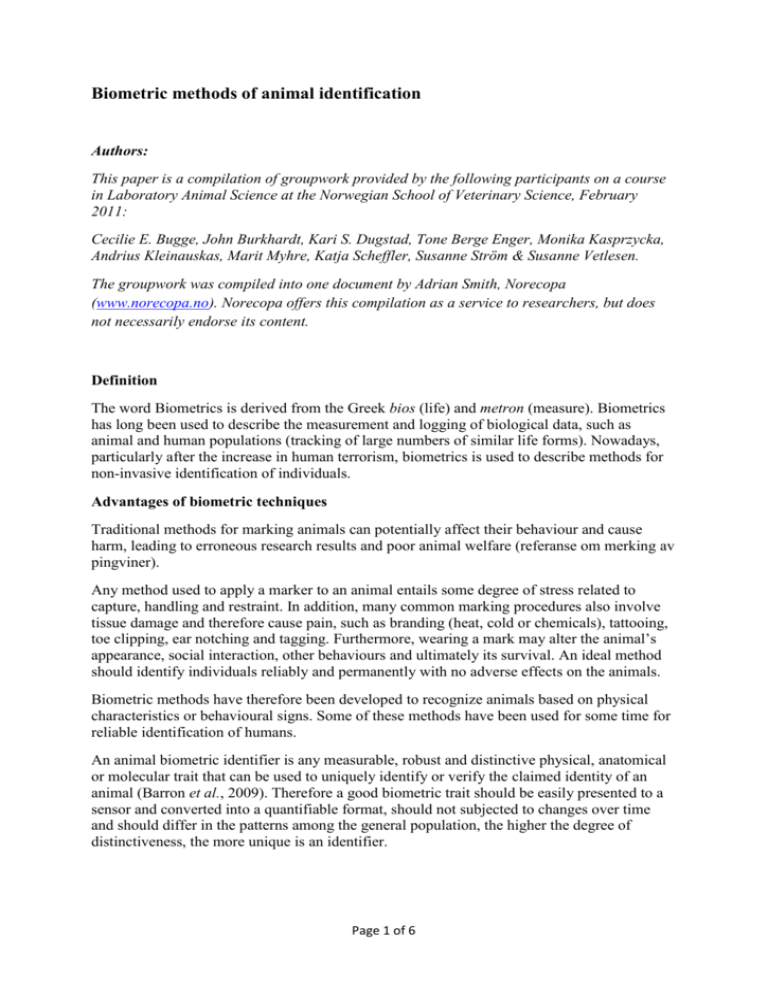
Biometric methods of animal identification Authors: This paper is a compilation of groupwork provided by the following participants on a course in Laboratory Animal Science at the Norwegian School of Veterinary Science, February 2011: Cecilie E. Bugge, John Burkhardt, Kari S. Dugstad, Tone Berge Enger, Monika Kasprzycka, Andrius Kleinauskas, Marit Myhre, Katja Scheffler, Susanne Ström & Susanne Vetlesen. The groupwork was compiled into one document by Adrian Smith, Norecopa (www.norecopa.no). Norecopa offers this compilation as a service to researchers, but does not necessarily endorse its content. Definition The word Biometrics is derived from the Greek bios (life) and metron (measure). Biometrics has long been used to describe the measurement and logging of biological data, such as animal and human populations (tracking of large numbers of similar life forms). Nowadays, particularly after the increase in human terrorism, biometrics is used to describe methods for non-invasive identification of individuals. Advantages of biometric techniques Traditional methods for marking animals can potentially affect their behaviour and cause harm, leading to erroneous research results and poor animal welfare (referanse om merking av pingviner). Any method used to apply a marker to an animal entails some degree of stress related to capture, handling and restraint. In addition, many common marking procedures also involve tissue damage and therefore cause pain, such as branding (heat, cold or chemicals), tattooing, toe clipping, ear notching and tagging. Furthermore, wearing a mark may alter the animal’s appearance, social interaction, other behaviours and ultimately its survival. An ideal method should identify individuals reliably and permanently with no adverse effects on the animals. Biometric methods have therefore been developed to recognize animals based on physical characteristics or behavioural signs. Some of these methods have been used for some time for reliable identification of humans. An animal biometric identifier is any measurable, robust and distinctive physical, anatomical or molecular trait that can be used to uniquely identify or verify the claimed identity of an animal (Barron et al., 2009). Therefore a good biometric trait should be easily presented to a sensor and converted into a quantifiable format, should not subjected to changes over time and should differ in the patterns among the general population, the higher the degree of distinctiveness, the more unique is an identifier. Page 1 of 6 Biometric methods are non-invasive, do not cause pain and do not alter the appearance of the animal. These methods will therefore have no effect on the behaviour and survivability of the animals, except in cases where repeated capture and/or handling is necessary. Examples of biometric identification methods Visual patterns Some species have external characteristics that are easy to recognize and that are unique for each individual animal. These include colour rings on snakes, body markings of zebras, belly patches in geese and eyespots on the wings of butterflies. These patterns can be photographed or filmed and used to recognize individual animals. Problems may occur in the field in different light settings or surroundings, but new techniques including digital photography and videofilimg have reduced these difficulties. Digital images can also be manipulated to make recognition easier. The method is cheap and at its simplest needs no more than paper and pencil. In addition, observations can be made at a distance, reducing the risk of stress and altered behaviour. The most obvious biometric marker is the coat pattern of animals which often appears on major body parts as colourations of either fur, feathers, skin or scales. For example, zebras and tigers can be identified from their stripes; cheetahs and African penguins carry unique spot patterns and snakes have coloured rings (Burghardt, 2008). In a Norwegian study, individuals of the Lesser White-fronted Goose, Anser erythropus, were identified by differences in individual belly patches. The patches were drawn and individuals followed over seven seasons with high accuracy. No individuals were found with similar patches (Øien et al., 1996). Two observers were always present to reduce the risk of mistakes. Photographic identification has been used since the 1970s to identify aquatic animals such as dolphins and whales (Rugh et al., 1998). Individual bottlenose dolphins can be identified by comparing photographs of their fins, which display curves, notches, nicks and tears. Whales can be distinguished by the callosity patterns on their heads (Wells, 2002). Figure 1. Dorsal fins of bottlenose dolphins displaying unique permanent characteristics used for their identification (© 2007 Dolphin Research Center, 58901 Overseas Highway, Grassy Key, FL 33050-6019, USA. http://www.dolphins.org/marineed_photoid.php). Nose-prints This method has been used to identify cattle and was first published by Petersen (1922). The method was developed to avoid the potential for fraud associated with traditional marking methods such as branding, tattooing and ear tags. Both sheep and cattle can be individually identified on the basis of the arrangement and distribution of ridges and valleys on the muzzle Page 2 of 6 (Ebert, 2006). The method is cheap and simple: ink is applied to the nose and used to make an impression on paper, rather like taking a finger-print from a human. Its accuracy depends, however, on each print being taken in the same way, with the same pressure, ink and type of paper to avoid confusing two animals. They may also be difficult to read due to smearing and they require a trained eye to verify a match. The method is therefore dependent upon the operator’s skills. Nose prints have been shown to be stable over time. Figure 2. Examples of bovine nose prints from Hirsch et al. (1952, http://www.sciencedirect.com/science/article/pii/S0022030252937077). Iris patterns Iris recognition technology was originally developed for use in humans but has been tested in animals (Musgrave & Cambier, 2002). Iris scanning can be performed rapidly and images can be captured digitally. Its use in animals is limited by the fact that the iris pattern does not stabilise until the animal is several months old and may undergo alteration following injury or infection. Retinal patterns The retinal vascular pattern is a unique and distinct biometric trait in animals. It is based upon the branching patterns of the retinal vessels which are present from birth and do not change during the animal’s life. Individual blood vessels in the eye can be detected using a retinal scanner. This pattern can be recorded with a hand-held device about the size of a video camera. Scans from individual animals are registered in a database. Some devices can also measure GPS coordinates. This method can be used when marking cattle and can be compared to nose-prints. The method is also relatively cheap. Page 3 of 6 Figure 3. Example of matching retinal images, from Rusk et al. (1986 http://www.joe.org/joe/2006october/a7.php). Retinal imaging and nose-prints of sheep and cattle were compared by Rusk et al. (1986). Nose-prints are a quicker method than retinal scanning, but retinal scans are easy to analyse for inexperienced operators (Howell et al., 2008). Computer software for the analysis of digital pictures from both retinal scana and nose-prints makes analysis faster, cheaper and more reliable. Facial recognition This method has been investigated as an identifier for sheep and was adapted from an independent-components algorithm for human face recognition (Corkery et al., 2007). However, despite the fact that this biometric method has been used by humans for thousands of years, it is difficult to design instruments that can perform facial recognition accurately. Ear vessel patterns Inspired by fingerprint identification of humans, the unique blood vessel pattern in the ear of rodents has been studied as a biometric identification method (Cameron et al., 2007). The animal’s ear is photographed from the front while applying backlight to provide a detailed, high-contrast picture of the blood vessels. The branching points of the ear’s blood vessels are automatically detected and compared between two images to identify the individual. Bite marks An impression of an animal’s bite marks can be used for identification purposes, in a similar fashion to its use in human forensic medicine. This method is not applicable to all animals and can be difficult to conduct without sedating the individual. For this reason, other methods are preferable. Saliva sampling Saliva contains DNA that can be used to recognize individual animals. The method is less invasive than the use of blood sampling to collect DNA. Movement patterns It has been suggested that aquatic animals can be identified by analysing their movement patterns using a tri-axial accelerometry device (Shepard et al., 2010). By measuring the movements of animals in three dimensions, their movement patterns can be stored and these Page 4 of 6 can be used to diagnose aberrant behavioural patterns, such as those associated with infections. Accelometery may have the potential to be a powerful tool to produce maps for conservation purposes, where animal movements can be plotted. Methods of relevance to biometric identification of fish There are very few published studies where biometric methods have been applied to fish or indeed other aquatic species, for identification purposes. As mentioned above, these have mainly been applied to mammals such as whales and dolphins (Rugh et al., 1998; Wells, 2002). Of the methods described above, external body patterns are likely to be the only biometric methods of any relevance in the foreseeable future: shapes (e.g. fins, callosity) patterns (e.g. number and distribution of spots) colours Retinal patterns and DNA collection from the skin mucous layer may be of use, but to our knowledge have not been investigated to date. References Barron UG, Butler F, McDonnell K & Ward S (2009): The end of the identity crisis? Advances in biometric markers for animal identification. Irish Veterinary Journal, 62, 204208. Burghardt T. (2008): A general introduction to visual animal biometrics. PhD Thesis, University of Bristol. Cameron J, Jacobson C, Nilsson K & Rögnvaldsson T (2007): Identifying laboratory rodents using earprints. http://www.nc3rs.org.uk/downloaddoc.asp?id=570&page=675&skin=0 Corkery G, Gonzales Baron U, Butler F et al. (2007): A preliminary investigation on face recognition as a biometric identifier of sheep. Trans. ASABE, 50, 313-320. Dolphin Research Center. The Use of Photo-Identification in Dolphin Research. http://www.dolphins.org/marineed_photoid.php Ebert B (2006): Identification of Beef Animals. http://www.aces.edu/pubs/docs/Y/YANR0170 Hirsch M, Graham EF & Dracy AE (1952): A classification for the identification of bovine noseprints. Journal of Dairy Science, 35, 314-319. http://www.sciencedirect.com/science/article/pii/S0022030252937077 Howell BM, Rusk CP, Blomeke CR, McKee RK, Lemenager RP (2008): Perceptions of Retinal Imaging Technology for Verifying the Identity of 4-H Ruminant Animals. Journal of Extension, 46. http://www.joe.org/joe/2008october/rb9.php Musgrave C, Cambier JL (2002) U.S. Patent No. 6424727: System and method of animal Page 5 of 6 identification and animal transaction authorization using iris patterns. Petersen WE (1922): The identification of the bovine by means of nose prints. J. Dairy Sci., 5:249-258. Rugh DJ, Zeh JE, Koski WR, Baraff LS, Miller GW & Shelden KEW (1998): An improved system for scoring photo quality and whale identifiability in aerial photographs of bowhead whales. Rep. int. Whal. Commn 48: 501-12. Rusk CP, Blomeke CR, Balschweid MA, Elliott SJ, Baker D (2006): An evaluation of retinal imaging technology for 4-H beef and sheep identification. J. Extens. 44 (5), Article 5FEA7. http://www.joe.org/joe/2006october/a7.php Shepard ELC, Wilson RP, Quintana F, Laich AG, Liebsch N, Albareda DA, Halsey LG, Gleiss A, Morgan DT, Myers AE, Newman C & Macdonald DW (2010): Identification of animal movement patterns using tri-axial accelometry. Endangered Species Research 10:4760. Wells RS (2002): Identification Methods. Pp. 601-608. In: Perrin W.F., Wursig B., Thewissen J.G.M. 2002. Encyclopedia of Marine Mammals. Academic Press. San Diego, CA. Øien IJ, Aarvak T, Lorentsen S-H & Bangjord G (1996): Use of individual differences in belly patches in population monitoring of Lesser White-fronted Goose Anser erythropus at a staging ground. Fauna norv. Ser. C, Cinclus 19:69–76. Page 6 of 6


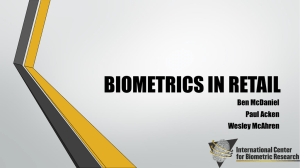

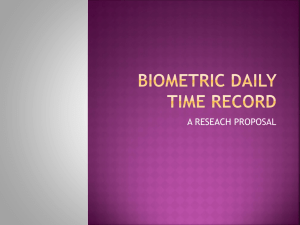
![[CLICK HERE AND TYPE TITLE]](http://s3.studylib.net/store/data/006863514_1-b5a6a5a7ab3f658a62cd69b774b6606c-300x300.png)
